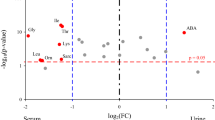Abstract
In previous studies we demonstrated increased amounts of phenylcarboxylic acids (PCA) in serum of patients with sepsis. This observation prompted the present study of the ability of the human microbiome bacteria to produce PCA in vitro. PCA were detected in culture media by gas chromatography-mass spectrometry. Increased amounts of phenyllactic and p-hydroxyphenyllactic acids were produced by Klebsiella pneumonia, Escherichia coli, and Staphylococcus aureus. Certain strict anaerobes (bifidobacteria, lactobacteria, eubacteria) have also been found to actively produce these PCA, but these bacteria are not etiologically linked to sepsis. Thus our results demonstrate the ability of sepsis-related bacteria to produce PCA and provide experimental support for the theory that the accumulation of PCA in the blood of patients with sepsis results from microbial degradation of phenylalanine and tyrosine.
Similar content being viewed by others
Abbreviations
- GC-MS:
-
gas chromatography-mass spectrometry
- HMDB:
-
Human Metabolome Database
- HPAA:
-
p-hydroxyphenylacetic acid
- HPLA:
-
p-hydroxyphenyllactic acid
- HPPA:
-
p-hydroxyphenylpropionic acid
- PAA:
-
phenylacetic acid
- PCA:
-
phenylcarboxylic acid
- PLA:
-
phenyllactic acid
- PPA:
-
phenylpropionic acid
- TMS:
-
trimethylsilyl
References
Backhed, F., Ley, R. E., Sonnenburg, J. L., Peterson, D. A., and Gordon, J. I. (2005) Science, 307, 1915–1920.
Beloborodova, N. V., and Osipov, G. A. (1999) Vest. RAMN, 7, 25–31.
Wikoff, W. R., Anfora, A. T., Liu, J., Schultz, P. G., Lesley, S. A., Peters, E. C., and Suizdak, G. (2009) Proc. Natl. Acad. Sci. USA, 106, 3698–3703.
Beloborodova, N. V., Arkhipova, A. S., Beloborodov, D. M., Boyko, N. B., Melko, A. I., and Olenin, A. Yu. (2006) Klin. Lab. Diagn., No. 2, 3–6.
Khodakova, A., and Beloborodova, N. (2007) Crit. Care, 11(Suppl. 4), 5.
Fedotseva, N. I., Kazakov, R. E., Kondrashova, M. N., and Beloborodova, N. V. (2008) Toxicol. Lett., 180, 182–188.
Levchuk, A. A., Palmina, N. P., and Raushenbakh, M. O. (1987) Byul. Eksp. Biol. Med., 104, 77–79.
Liu, J., Li, J., and Sidell, N. (2007) Cancer Chemother. Pharmacol., 59, 217–225.
Bourgeau, G., and Mayrand, D. (1983) Can. J. Microbiol., 29, 1184–1189.
Mayrand, D. (1979) Can. J. Microbiol., 25, 927–928.
Moss, C. W., Lambert, M. A., and Goldsmith, D. J. (1970) Appl. Microbiol., 19, 375–378.
Smith, E. A., and Macfarlane, G. T. (1996) J. Appl. Bacteriol., 81, 288–302.
Deutsch, J. C. (1997) J. Chromatogr. B Biomed. Sci. Appl., 690, 1–6.
Curtius, H.-Ch., Vollmin, J. A., and Baerlocher, K. (1973) Anal. Chem., 45, 1107–1110.
Arias-Barrau, E., Olivera, E. R., Luengo, J. M., Fernandez, C., Galan, B., Garcia, J. L., Diaz, E., and Minambres, B. (2004) J. Bacteriol., 186, 5062–5077.
Sparnins, V. L., and Chapman, P. J. (1976) J. Bacteriol., 127, 362–366.
Lambert, M. A., and Moss, C. W. (1980) J. Clin. Microbiol., 12, 291–293.
Mao, L. F., Chu, C., and Schulz, H. (1994) Biochemistry, 33, 3320–3326.
Clemens, P. C., Schunemann, M. H., Hoffman, G. F., and Kohlschutter, A. (1990) J. Inher. Metab. Dis., 13, 227–228.
Nakamura, K., Tanaka, Y., Mitsubuchi, H., and Endo, F. (2007) J. Nutr., 137, 1556S–1560S.
Kopple, J. D. (2007) J. Nutr., 137, 1586S–1590S.
Leibich, H. M., and Pickert, A. (1985) J. Chromatogr., 338, 25–32.
Haan, E., Brown, G., Bankier, A., Mitchell, D., Hunt, S., and Barnes, G. (1985) Eur. J. Nutr., 144, 63–65.
Shenderov, B. A. (1998) Medical Microbial Etiology and Functional Nutrition [in Russian], Vols. 1–3, Grant, Moscow.
Author information
Authors and Affiliations
Corresponding author
Additional information
Original Russian Text © N. V. Beloborodova, A. S. Khodakova, I. T. Bairamov, A. Yu. Olenin, 2009, published in Biokhimiya, 2009, Vol. 74, No. 12, pp. 1657–1663.
Originally published in Biochemistry (Moscow) On-Line Papers in Press, as Manuscript BM09-129, July 5, 2009.
Rights and permissions
About this article
Cite this article
Beloborodov, N.V., Khodakova, A.S., Bairamov, I.T. et al. Microbial origin of phenylcarboxylic acids in the human body. Biochemistry Moscow 74, 1350–1355 (2009). https://doi.org/10.1134/S0006297909120086
Received:
Revised:
Published:
Issue Date:
DOI: https://doi.org/10.1134/S0006297909120086



